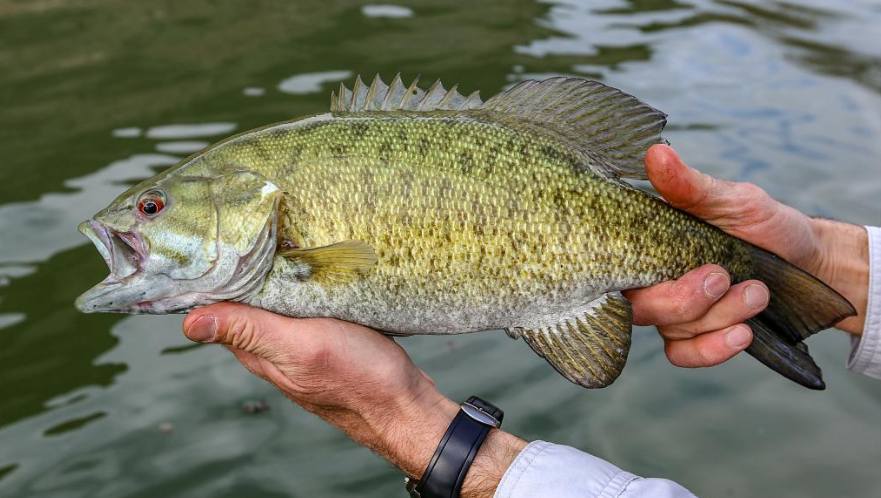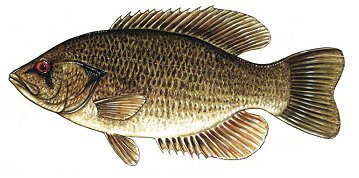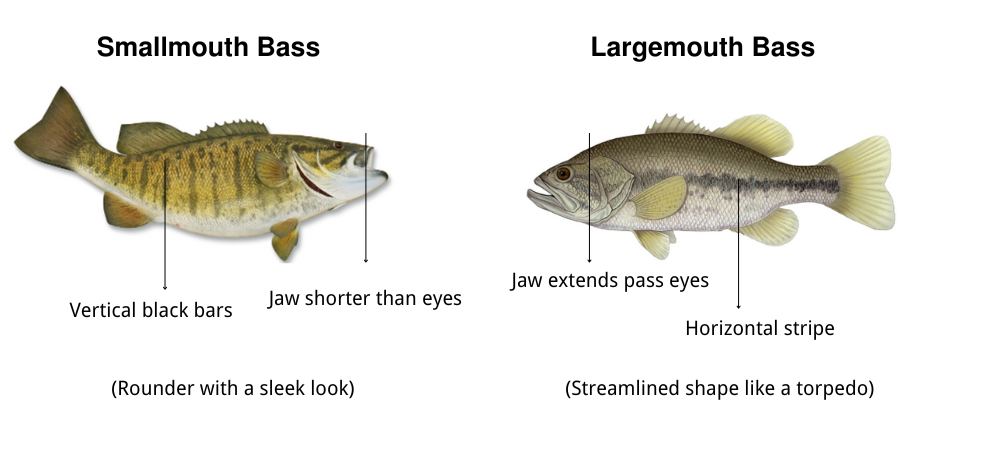Hey there, angler enthusiasts! Ever reeled in a smallmouth bass with eyes that looked like burning embers? You might be surprised to learn that red eyes aren’t as uncommon in these feisty fighters as you’d think.
There’s a whole debate about whether it’s a rare anomaly or just another part of the smallmouth’s surprising color palette. So, lace up your shoes and get ready to dive deep (pun intended) into the world of red-eyed bass.
We’ll explore what a typical smallmouth looks like, why some sport fiery peepers, and even how to tell them apart from their look-alike cousins, the rock bass. Let’s see if we can shed some light on this fishy phenomenon!
Does Smallmouth Bass Have Red Eyes?

Yes, smallmouth bass can have red eyes! It’s one of the characteristic features that can help you distinguish them from other types of bass. Their eye color can range from red to brown.
Here’s a quick rundown of what a Smallmouth Bass looks like:
Body: Slim, streamlined, and designed for swift flow of water in fast-moving currents.
Coloration: Olive-green, gold, and dark brown in a randomly assorted pattern. The exact colors may vary with the above factors such as fish’s age, habitat, water quality, diet, and spawning cycle.
Mouth: A chin that just reaches the eye boundary without connecting to the tonsils like largemouth bass whose jaws extend beyond the eyes.
Fins: Two back fins, the front being spiny and the back soft rays. The pectoral fins are the most visible features that stand out, these fins are located high on the body. On its back, the tail fin is flattened at its last part.
Eyes: Red or brown as mentioned earlier.
Are Red-Eye Smallmouth Bass Rare?
The smallmouth bass may get red eyes — the most common being red –, but it is not the most common color they have. The red eyes of smallmouth bass are not scientifically explained, but it is a cool feature one should be aware of when fishing next time.
Why Do Smallmouth Bass Have Red Eyes?
Smallmouth bass, like many other bass species, have red eyes due to a special adaptation called the tapetum lucidum.
This layer behind their retina acts like a mirror, reflecting light through the light-sensitive cells, giving them a second chance to capture incoming light.
Two main factors contribute to the red eye color in smallmouth bass:
- Tapetum Lucidum:This reflective layer is rich in blood vessels, which gives the eyes their characteristic red color.
- Abundance of Blood Vessels:The choroid layer, specifically, has a high concentration of blood vessels. These vessels provide essential oxygen and nutrients to the retina, but their abundance also contributes to red coloration.
Rock Bass Vs Smallmouth

Rock bass and smallmouth bass are both freshwater fish, but they are distinct species with some key differences.
Similarities
- Both have two dorsal fins.
- Both have red eyes (though the shades can differ slightly).
- Both are considered game fish for anglers.
Main Differences
- Body Shape: Rock bass usually have a slightly rounder body shape like the bluegill (sunfish), but smallmouth bass tends to be slenderer and more elongated.
- Size: Rock bass are generally smaller, usually 6-10 inches, while smallmouth bass can grow a lot larger and weigh above 20 pounds.
- Coloration: The spotted Rock bass has small, irregular dark-blue dots and indented green sides. The selective coloration of smallmouth bass is done through greenish-brown or olive color with vertical lines or stripes along the body.
- Fins: Rock bass dorsal fins are hard to differentiate from those of smallmouth bass because there is a continuity in the spiny and soft rays compared to the definite separation in smallmouth bass.
- Habitat: The rock bass prefers rocky areas in lakes and streams, the smallmouth bass enjoys moving waters with cool water and gravel or rocky bottom.
How To Tell a Rock Bass Or a Red-Eyed Smallmouth?
To quickly define the fish species you have caught, here is the factors to look into:
Body Shape: Concentrate on the rock bass’s fuller body and broader base compared to a smallmouth’s elongated and narrow image.
Coloration: Look for the dots on the sides of rock basses and the bars that run vertically for the smallmouths.
Fins: Look for the dorsal fins that are more connected in the rock bass and get separated into the spiny and soft rays in the smallmouth’s fins.
🔔Bonus Tip: some may confuse smallmouth bass and largemouth bass. Here are the main differences between them:
The most obvious indication is the size of the mouth. While observing a Largemouth Bass, you will notice its mouth extends beyond the eye, whereas for the Smallmouth Bass, the mouth is situated below the eye.
Typically, the color of a Largemouth Bass is green and it has dark patches that form a stripe going horizontally across the middle of the fish on each side. In contrast, a Smallmouth Bass has vertical black bars instead of a horizontal stripe.

What Are Some Bass With Red Eyes?
Here are some common examples of fishes that have red eyes:
- Smallmouth Bass (Micropterus Dolomite)
As we discussed earlier, smallmouth bass have a slender, elongated body with greenish-brown or olive coloration and vertical bars on their sides.
- Largemouth Bass (Micropterus Salmoides)
Largemouth bass are named for their large mouths, which extend past their eye. They have a stockier body than smallmouth bass and a greenish-brown coloration with a horizontal stripe along their side.
- Spotted Bass (Micropterus Punctulatus)
Spotted bass are similar to smallmouth bass but have a slightly deeper body and smaller scales. They have a greenish-brown coloration with dark spots on their sides.
- Guadalupe Bass (Micropterus Treculii)
Guadalupe bass are a threatened species found only in the Guadalupe River system in Texas. They have a similar body shape to smallmouth bass but with a more colorful body with green, bronze, and yellow hues.
- Redeye Bass (Micropterus Floridanus)
Redeye bass are native to the southeastern United States. They have a stockier body than smallmouth bass and a greenish-brown coloration with a distinctive red horizontal stripe along their eye.
Conclusion
To sum up, the red eye is one of the most easily spotted identifying features of smallmouth bass, which is caused by a tapetum lucidum that is a reflective layer and intended to boost vision in low sunlight.
On the other hand, it’s not the most common eye color, but it’s a particular, attention-drawing one. We delved into how to discriminate smallmouth bass from their twin, the rock bass, by their appearance characteristics and other distinctive details.
Ultimately, we focused on other types of bass with the red-eye characteristic. Hence, while you land a smallmouth bass next time, take a closer look at its eyes, perhaps, you’ll see a burning ember staring back!




















Leave a reply